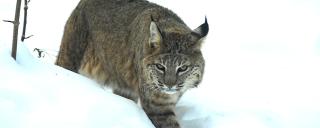
Bobcat
Fact Sheet | |
|---|---|
Scientific Name | Lynx rufus |
Description | Bobcats are about twice the size of a domestic cat with relatively long legs, short, bobbed tail, pointed ears and a facial ruff. Bobcats have soft, medium-length fur that ranges from reddish to gray, with a highly variable amount of black spotting. Their bellies are typically white with black spots. |
Tracks | Front/Rear– 2" L,1-3/4" W Walking stride: 6" - 14" |
Total Length | 29-46 inches |
Weight | 15-38 pounds |
Habitat | Bobcats prefer rugged or wooded habitats that afford them the ability to stalk prey. |
Breeding Season | February-March |
Gestation Period | 60 days |
Litter Size | 2-4 (average 3) |
Social Aspects | Solitary, except when breeding or rearing young. |
Status | Bobcats are primarily found in the western Badlands and northeastern Pembina Gorge regions, but also occur along streams and rivers elsewhere in the state. There is a regulated hunting and trapping season for bobcats. |
Food Habits | Bobcats are strictly carnivorous, with rabbits their primary prey. The rest of their diet is made up of other small rodents such as squirrels, mice and voles. However, bobcats are opportunistic, so they will take advantage of other prey such as birds and deer (mostly fawns or carrion). |
Fun Facts | Bobcats are members of the lynx genus and are often confused with the Canada lynx (Lynx canadensis). Bobcats are differentiated from Canada lynx by their shorter ear tufts, less distinct facial ruff , smaller feet, and tail tip that only has black on top (tail tip of the Canada lynx is black on top and bottom). However, bobcats and Canada lynx have been known to hybridize in the wild. |

